Conformity in Cognitive and Social Psychology: Theories and Impacts
VerifiedAdded on 2021/04/21
|9
|2405
|146
Essay
AI Summary
This essay delves into the multifaceted concept of conformity within the realms of cognitive and social psychology. It begins by defining conformity as the alteration of behavior to align with others, differentiating between normative and informational conformity. The essay then explores key theories, including social comparison theory, which examines self-evaluation and competition, and social influence theory, which provides an umbrella for understanding various influences on behavior. The positive and negative aspects of conformity are discussed, highlighting how it can facilitate social cohesion or lead to detrimental outcomes. Finally, the essay examines the impacts of conformity on social workers, emphasizing the importance of understanding and navigating these dynamics when assisting others, and the potential for both positive and negative influences in their professional roles. References to relevant research and studies are also provided.
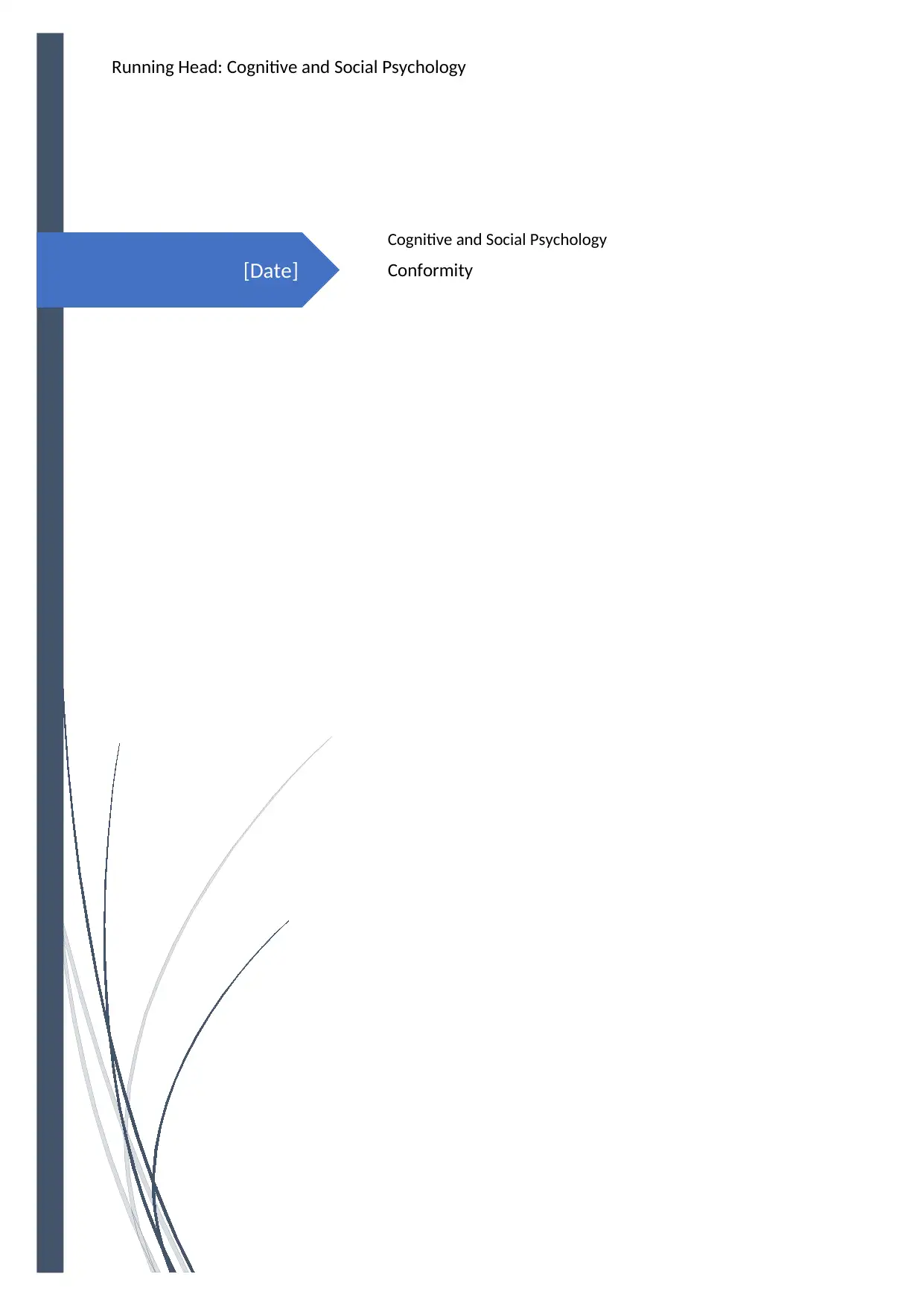
[Date]
Running Head: Cognitive and Social Psychology
Cognitive and Social Psychology
Conformity
Running Head: Cognitive and Social Psychology
Cognitive and Social Psychology
Conformity
Paraphrase This Document
Need a fresh take? Get an instant paraphrase of this document with our AI Paraphraser
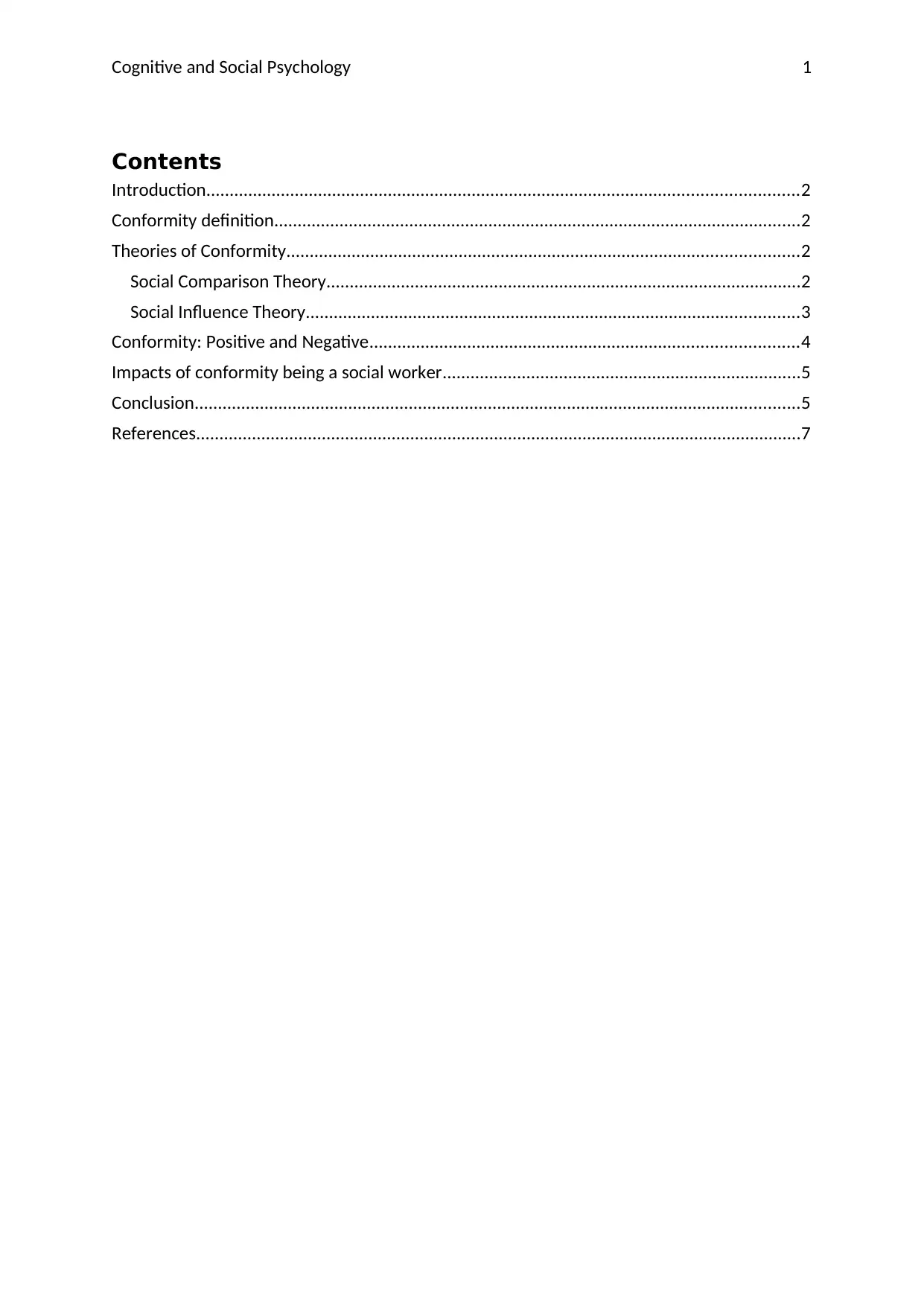
Cognitive and Social Psychology
Contents
Introduction...............................................................................................................................2
Conformity definition.................................................................................................................2
Theories of Conformity..............................................................................................................2
Social Comparison Theory......................................................................................................2
Social Influence Theory..........................................................................................................3
Conformity: Positive and Negative............................................................................................4
Impacts of conformity being a social worker.............................................................................5
Conclusion..................................................................................................................................5
References..................................................................................................................................7
1
Contents
Introduction...............................................................................................................................2
Conformity definition.................................................................................................................2
Theories of Conformity..............................................................................................................2
Social Comparison Theory......................................................................................................2
Social Influence Theory..........................................................................................................3
Conformity: Positive and Negative............................................................................................4
Impacts of conformity being a social worker.............................................................................5
Conclusion..................................................................................................................................5
References..................................................................................................................................7
1
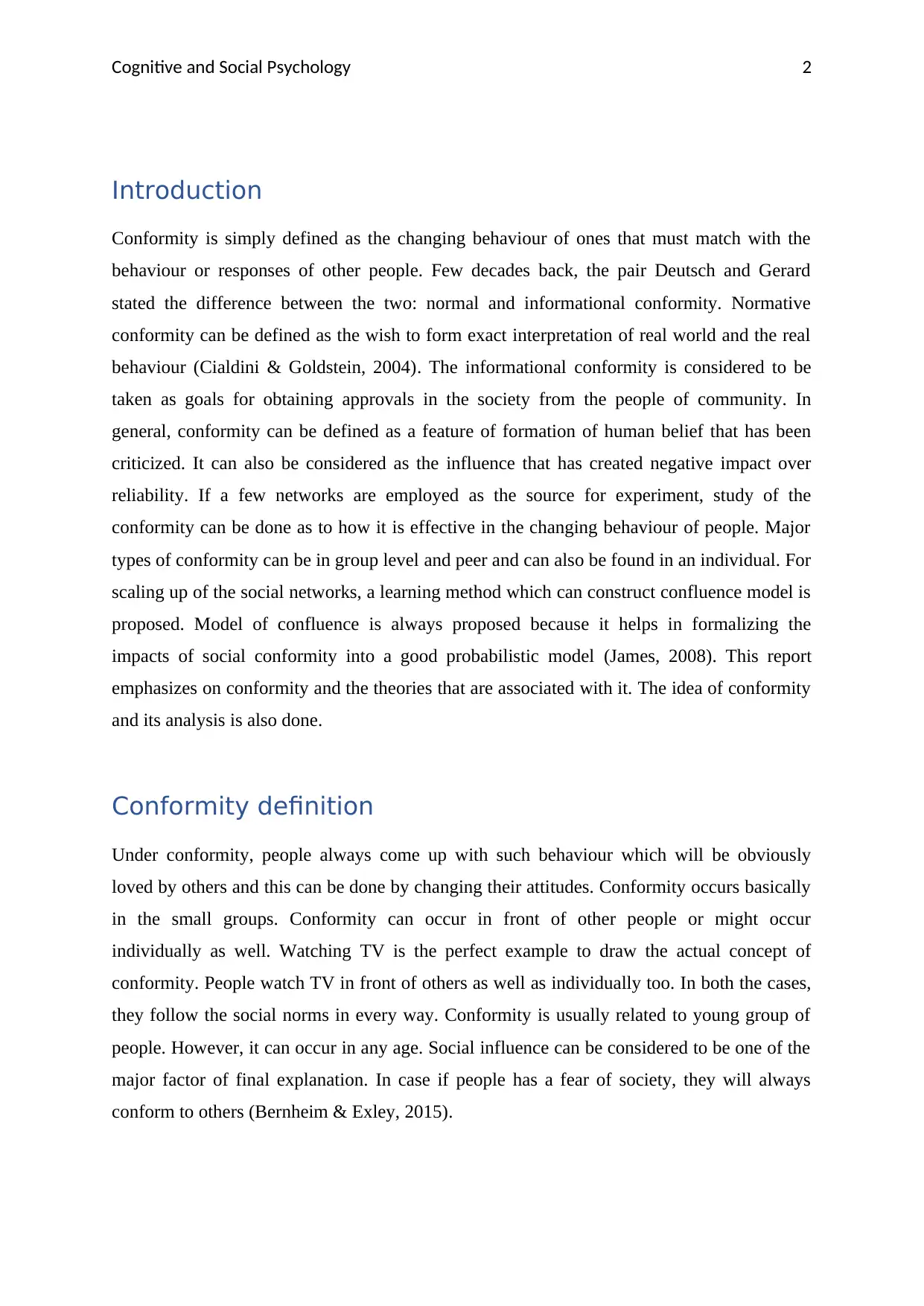
Cognitive and Social Psychology
Introduction
Conformity is simply defined as the changing behaviour of ones that must match with the
behaviour or responses of other people. Few decades back, the pair Deutsch and Gerard
stated the difference between the two: normal and informational conformity. Normative
conformity can be defined as the wish to form exact interpretation of real world and the real
behaviour (Cialdini & Goldstein, 2004). The informational conformity is considered to be
taken as goals for obtaining approvals in the society from the people of community. In
general, conformity can be defined as a feature of formation of human belief that has been
criticized. It can also be considered as the influence that has created negative impact over
reliability. If a few networks are employed as the source for experiment, study of the
conformity can be done as to how it is effective in the changing behaviour of people. Major
types of conformity can be in group level and peer and can also be found in an individual. For
scaling up of the social networks, a learning method which can construct confluence model is
proposed. Model of confluence is always proposed because it helps in formalizing the
impacts of social conformity into a good probabilistic model (James, 2008). This report
emphasizes on conformity and the theories that are associated with it. The idea of conformity
and its analysis is also done.
Conformity definition
Under conformity, people always come up with such behaviour which will be obviously
loved by others and this can be done by changing their attitudes. Conformity occurs basically
in the small groups. Conformity can occur in front of other people or might occur
individually as well. Watching TV is the perfect example to draw the actual concept of
conformity. People watch TV in front of others as well as individually too. In both the cases,
they follow the social norms in every way. Conformity is usually related to young group of
people. However, it can occur in any age. Social influence can be considered to be one of the
major factor of final explanation. In case if people has a fear of society, they will always
conform to others (Bernheim & Exley, 2015).
2
Introduction
Conformity is simply defined as the changing behaviour of ones that must match with the
behaviour or responses of other people. Few decades back, the pair Deutsch and Gerard
stated the difference between the two: normal and informational conformity. Normative
conformity can be defined as the wish to form exact interpretation of real world and the real
behaviour (Cialdini & Goldstein, 2004). The informational conformity is considered to be
taken as goals for obtaining approvals in the society from the people of community. In
general, conformity can be defined as a feature of formation of human belief that has been
criticized. It can also be considered as the influence that has created negative impact over
reliability. If a few networks are employed as the source for experiment, study of the
conformity can be done as to how it is effective in the changing behaviour of people. Major
types of conformity can be in group level and peer and can also be found in an individual. For
scaling up of the social networks, a learning method which can construct confluence model is
proposed. Model of confluence is always proposed because it helps in formalizing the
impacts of social conformity into a good probabilistic model (James, 2008). This report
emphasizes on conformity and the theories that are associated with it. The idea of conformity
and its analysis is also done.
Conformity definition
Under conformity, people always come up with such behaviour which will be obviously
loved by others and this can be done by changing their attitudes. Conformity occurs basically
in the small groups. Conformity can occur in front of other people or might occur
individually as well. Watching TV is the perfect example to draw the actual concept of
conformity. People watch TV in front of others as well as individually too. In both the cases,
they follow the social norms in every way. Conformity is usually related to young group of
people. However, it can occur in any age. Social influence can be considered to be one of the
major factor of final explanation. In case if people has a fear of society, they will always
conform to others (Bernheim & Exley, 2015).
2
⊘ This is a preview!⊘
Do you want full access?
Subscribe today to unlock all pages.

Trusted by 1+ million students worldwide
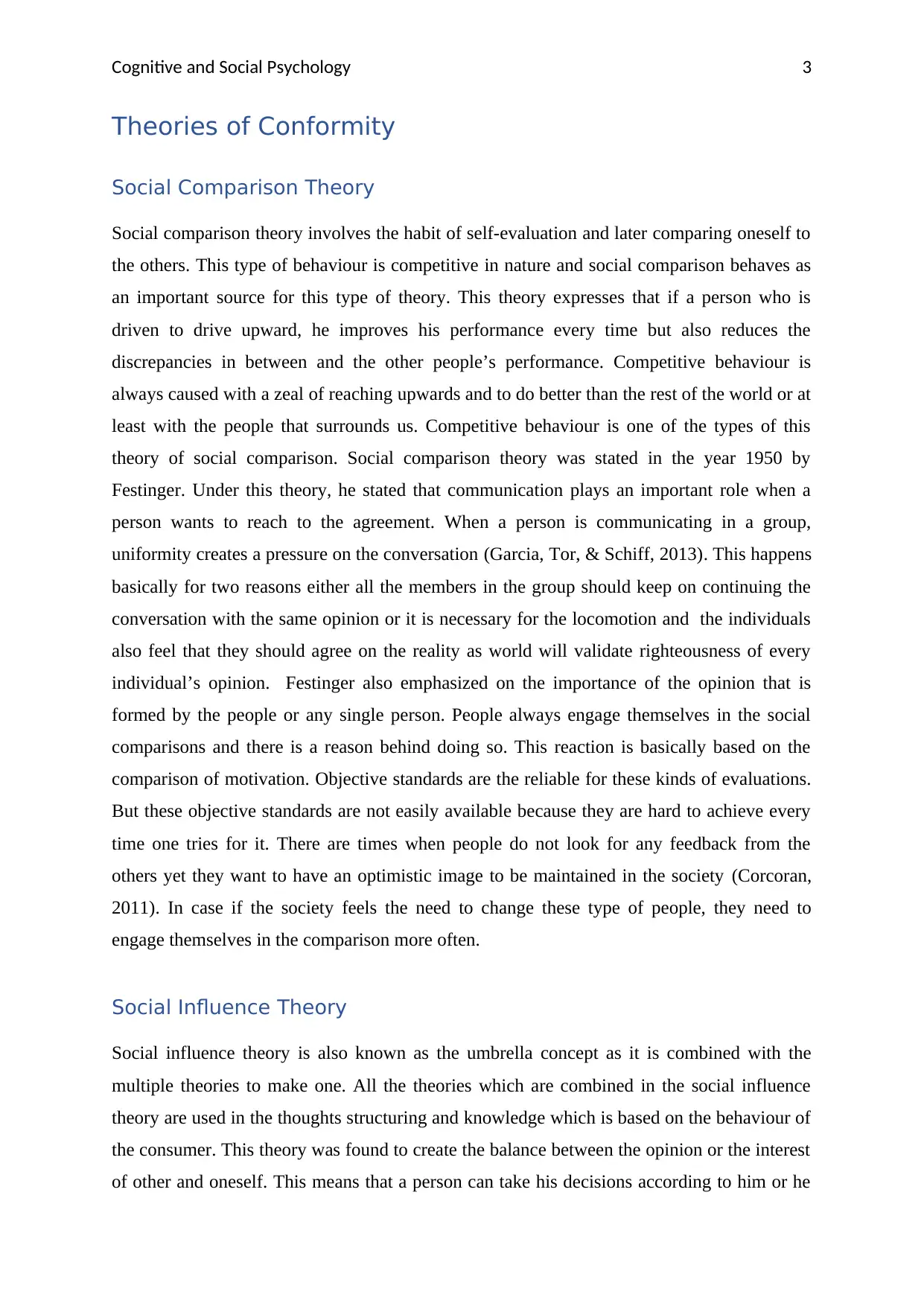
Cognitive and Social Psychology
Theories of Conformity
Social Comparison Theory
Social comparison theory involves the habit of self-evaluation and later comparing oneself to
the others. This type of behaviour is competitive in nature and social comparison behaves as
an important source for this type of theory. This theory expresses that if a person who is
driven to drive upward, he improves his performance every time but also reduces the
discrepancies in between and the other people’s performance. Competitive behaviour is
always caused with a zeal of reaching upwards and to do better than the rest of the world or at
least with the people that surrounds us. Competitive behaviour is one of the types of this
theory of social comparison. Social comparison theory was stated in the year 1950 by
Festinger. Under this theory, he stated that communication plays an important role when a
person wants to reach to the agreement. When a person is communicating in a group,
uniformity creates a pressure on the conversation (Garcia, Tor, & Schiff, 2013). This happens
basically for two reasons either all the members in the group should keep on continuing the
conversation with the same opinion or it is necessary for the locomotion and the individuals
also feel that they should agree on the reality as world will validate righteousness of every
individual’s opinion. Festinger also emphasized on the importance of the opinion that is
formed by the people or any single person. People always engage themselves in the social
comparisons and there is a reason behind doing so. This reaction is basically based on the
comparison of motivation. Objective standards are the reliable for these kinds of evaluations.
But these objective standards are not easily available because they are hard to achieve every
time one tries for it. There are times when people do not look for any feedback from the
others yet they want to have an optimistic image to be maintained in the society (Corcoran,
2011). In case if the society feels the need to change these type of people, they need to
engage themselves in the comparison more often.
Social Influence Theory
Social influence theory is also known as the umbrella concept as it is combined with the
multiple theories to make one. All the theories which are combined in the social influence
theory are used in the thoughts structuring and knowledge which is based on the behaviour of
the consumer. This theory was found to create the balance between the opinion or the interest
of other and oneself. This means that a person can take his decisions according to him or he
3
Theories of Conformity
Social Comparison Theory
Social comparison theory involves the habit of self-evaluation and later comparing oneself to
the others. This type of behaviour is competitive in nature and social comparison behaves as
an important source for this type of theory. This theory expresses that if a person who is
driven to drive upward, he improves his performance every time but also reduces the
discrepancies in between and the other people’s performance. Competitive behaviour is
always caused with a zeal of reaching upwards and to do better than the rest of the world or at
least with the people that surrounds us. Competitive behaviour is one of the types of this
theory of social comparison. Social comparison theory was stated in the year 1950 by
Festinger. Under this theory, he stated that communication plays an important role when a
person wants to reach to the agreement. When a person is communicating in a group,
uniformity creates a pressure on the conversation (Garcia, Tor, & Schiff, 2013). This happens
basically for two reasons either all the members in the group should keep on continuing the
conversation with the same opinion or it is necessary for the locomotion and the individuals
also feel that they should agree on the reality as world will validate righteousness of every
individual’s opinion. Festinger also emphasized on the importance of the opinion that is
formed by the people or any single person. People always engage themselves in the social
comparisons and there is a reason behind doing so. This reaction is basically based on the
comparison of motivation. Objective standards are the reliable for these kinds of evaluations.
But these objective standards are not easily available because they are hard to achieve every
time one tries for it. There are times when people do not look for any feedback from the
others yet they want to have an optimistic image to be maintained in the society (Corcoran,
2011). In case if the society feels the need to change these type of people, they need to
engage themselves in the comparison more often.
Social Influence Theory
Social influence theory is also known as the umbrella concept as it is combined with the
multiple theories to make one. All the theories which are combined in the social influence
theory are used in the thoughts structuring and knowledge which is based on the behaviour of
the consumer. This theory was found to create the balance between the opinion or the interest
of other and oneself. This means that a person can take his decisions according to him or he
3
Paraphrase This Document
Need a fresh take? Get an instant paraphrase of this document with our AI Paraphraser
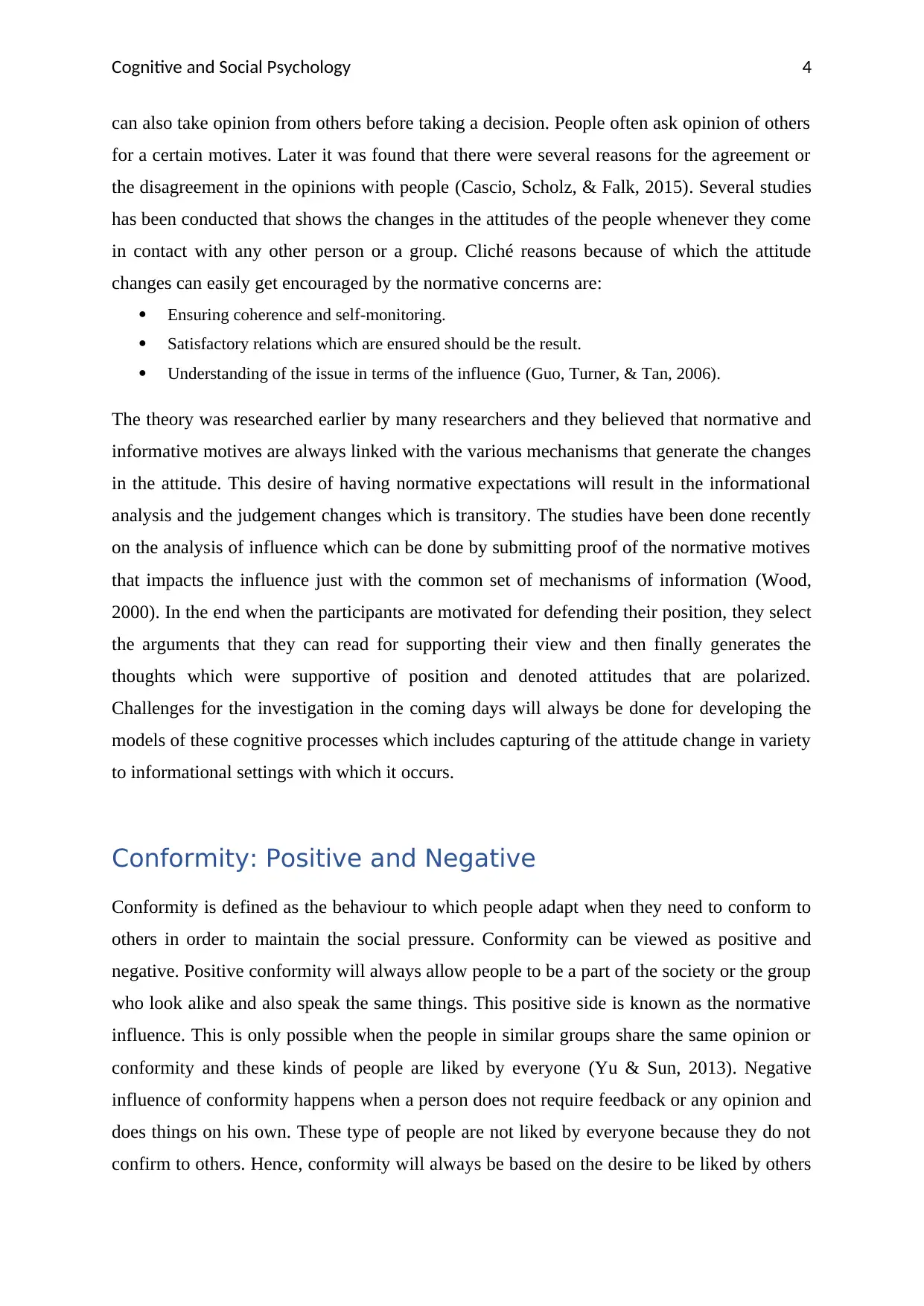
Cognitive and Social Psychology
can also take opinion from others before taking a decision. People often ask opinion of others
for a certain motives. Later it was found that there were several reasons for the agreement or
the disagreement in the opinions with people (Cascio, Scholz, & Falk, 2015). Several studies
has been conducted that shows the changes in the attitudes of the people whenever they come
in contact with any other person or a group. Cliché reasons because of which the attitude
changes can easily get encouraged by the normative concerns are:
Ensuring coherence and self-monitoring.
Satisfactory relations which are ensured should be the result.
Understanding of the issue in terms of the influence (Guo, Turner, & Tan, 2006).
The theory was researched earlier by many researchers and they believed that normative and
informative motives are always linked with the various mechanisms that generate the changes
in the attitude. This desire of having normative expectations will result in the informational
analysis and the judgement changes which is transitory. The studies have been done recently
on the analysis of influence which can be done by submitting proof of the normative motives
that impacts the influence just with the common set of mechanisms of information (Wood,
2000). In the end when the participants are motivated for defending their position, they select
the arguments that they can read for supporting their view and then finally generates the
thoughts which were supportive of position and denoted attitudes that are polarized.
Challenges for the investigation in the coming days will always be done for developing the
models of these cognitive processes which includes capturing of the attitude change in variety
to informational settings with which it occurs.
Conformity: Positive and Negative
Conformity is defined as the behaviour to which people adapt when they need to conform to
others in order to maintain the social pressure. Conformity can be viewed as positive and
negative. Positive conformity will always allow people to be a part of the society or the group
who look alike and also speak the same things. This positive side is known as the normative
influence. This is only possible when the people in similar groups share the same opinion or
conformity and these kinds of people are liked by everyone (Yu & Sun, 2013). Negative
influence of conformity happens when a person does not require feedback or any opinion and
does things on his own. These type of people are not liked by everyone because they do not
confirm to others. Hence, conformity will always be based on the desire to be liked by others
4
can also take opinion from others before taking a decision. People often ask opinion of others
for a certain motives. Later it was found that there were several reasons for the agreement or
the disagreement in the opinions with people (Cascio, Scholz, & Falk, 2015). Several studies
has been conducted that shows the changes in the attitudes of the people whenever they come
in contact with any other person or a group. Cliché reasons because of which the attitude
changes can easily get encouraged by the normative concerns are:
Ensuring coherence and self-monitoring.
Satisfactory relations which are ensured should be the result.
Understanding of the issue in terms of the influence (Guo, Turner, & Tan, 2006).
The theory was researched earlier by many researchers and they believed that normative and
informative motives are always linked with the various mechanisms that generate the changes
in the attitude. This desire of having normative expectations will result in the informational
analysis and the judgement changes which is transitory. The studies have been done recently
on the analysis of influence which can be done by submitting proof of the normative motives
that impacts the influence just with the common set of mechanisms of information (Wood,
2000). In the end when the participants are motivated for defending their position, they select
the arguments that they can read for supporting their view and then finally generates the
thoughts which were supportive of position and denoted attitudes that are polarized.
Challenges for the investigation in the coming days will always be done for developing the
models of these cognitive processes which includes capturing of the attitude change in variety
to informational settings with which it occurs.
Conformity: Positive and Negative
Conformity is defined as the behaviour to which people adapt when they need to conform to
others in order to maintain the social pressure. Conformity can be viewed as positive and
negative. Positive conformity will always allow people to be a part of the society or the group
who look alike and also speak the same things. This positive side is known as the normative
influence. This is only possible when the people in similar groups share the same opinion or
conformity and these kinds of people are liked by everyone (Yu & Sun, 2013). Negative
influence of conformity happens when a person does not require feedback or any opinion and
does things on his own. These type of people are not liked by everyone because they do not
confirm to others. Hence, conformity will always be based on the desire to be liked by others
4
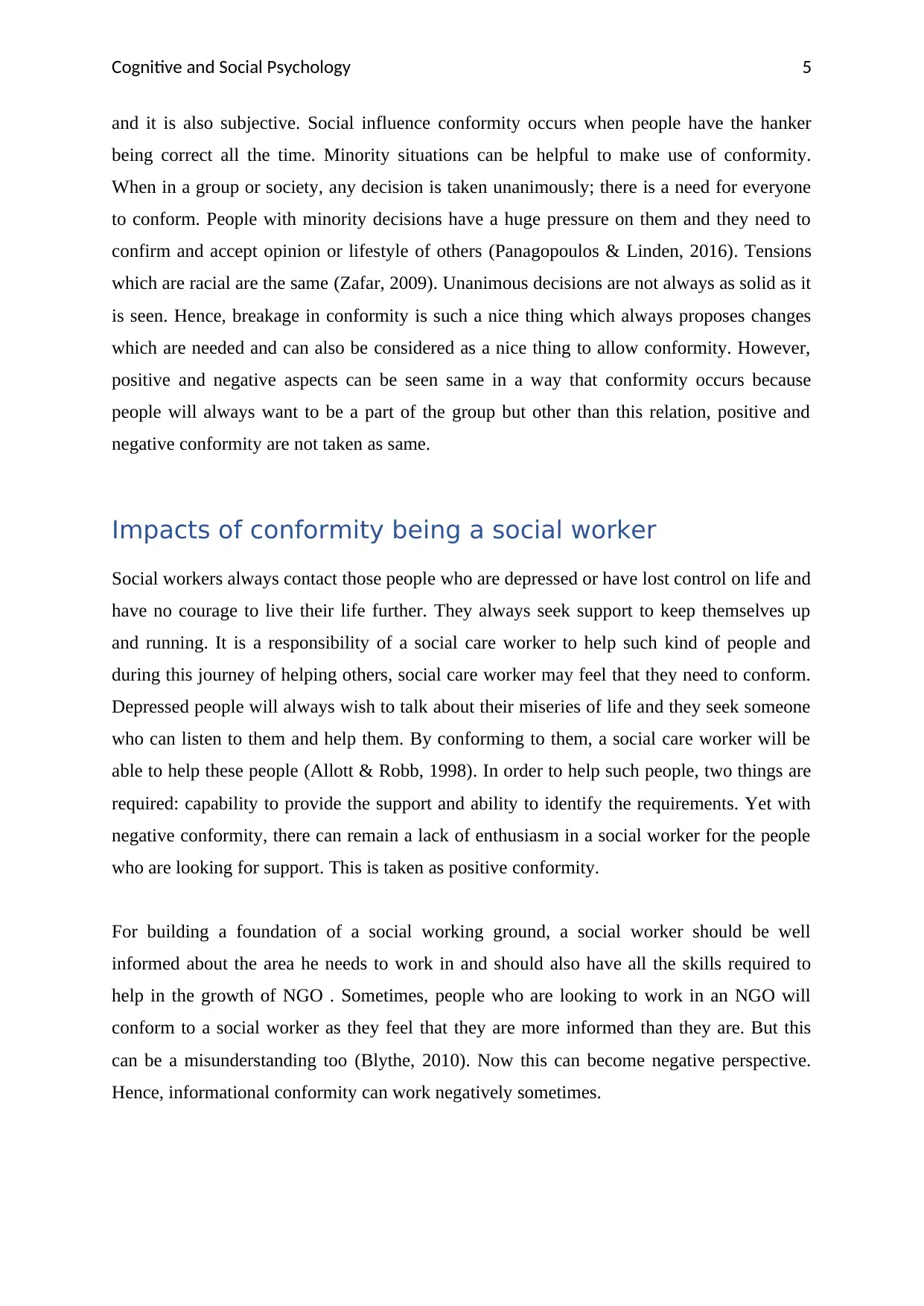
Cognitive and Social Psychology
and it is also subjective. Social influence conformity occurs when people have the hanker
being correct all the time. Minority situations can be helpful to make use of conformity.
When in a group or society, any decision is taken unanimously; there is a need for everyone
to conform. People with minority decisions have a huge pressure on them and they need to
confirm and accept opinion or lifestyle of others (Panagopoulos & Linden, 2016). Tensions
which are racial are the same (Zafar, 2009). Unanimous decisions are not always as solid as it
is seen. Hence, breakage in conformity is such a nice thing which always proposes changes
which are needed and can also be considered as a nice thing to allow conformity. However,
positive and negative aspects can be seen same in a way that conformity occurs because
people will always want to be a part of the group but other than this relation, positive and
negative conformity are not taken as same.
Impacts of conformity being a social worker
Social workers always contact those people who are depressed or have lost control on life and
have no courage to live their life further. They always seek support to keep themselves up
and running. It is a responsibility of a social care worker to help such kind of people and
during this journey of helping others, social care worker may feel that they need to conform.
Depressed people will always wish to talk about their miseries of life and they seek someone
who can listen to them and help them. By conforming to them, a social care worker will be
able to help these people (Allott & Robb, 1998). In order to help such people, two things are
required: capability to provide the support and ability to identify the requirements. Yet with
negative conformity, there can remain a lack of enthusiasm in a social worker for the people
who are looking for support. This is taken as positive conformity.
For building a foundation of a social working ground, a social worker should be well
informed about the area he needs to work in and should also have all the skills required to
help in the growth of NGO . Sometimes, people who are looking to work in an NGO will
conform to a social worker as they feel that they are more informed than they are. But this
can be a misunderstanding too (Blythe, 2010). Now this can become negative perspective.
Hence, informational conformity can work negatively sometimes.
5
and it is also subjective. Social influence conformity occurs when people have the hanker
being correct all the time. Minority situations can be helpful to make use of conformity.
When in a group or society, any decision is taken unanimously; there is a need for everyone
to conform. People with minority decisions have a huge pressure on them and they need to
confirm and accept opinion or lifestyle of others (Panagopoulos & Linden, 2016). Tensions
which are racial are the same (Zafar, 2009). Unanimous decisions are not always as solid as it
is seen. Hence, breakage in conformity is such a nice thing which always proposes changes
which are needed and can also be considered as a nice thing to allow conformity. However,
positive and negative aspects can be seen same in a way that conformity occurs because
people will always want to be a part of the group but other than this relation, positive and
negative conformity are not taken as same.
Impacts of conformity being a social worker
Social workers always contact those people who are depressed or have lost control on life and
have no courage to live their life further. They always seek support to keep themselves up
and running. It is a responsibility of a social care worker to help such kind of people and
during this journey of helping others, social care worker may feel that they need to conform.
Depressed people will always wish to talk about their miseries of life and they seek someone
who can listen to them and help them. By conforming to them, a social care worker will be
able to help these people (Allott & Robb, 1998). In order to help such people, two things are
required: capability to provide the support and ability to identify the requirements. Yet with
negative conformity, there can remain a lack of enthusiasm in a social worker for the people
who are looking for support. This is taken as positive conformity.
For building a foundation of a social working ground, a social worker should be well
informed about the area he needs to work in and should also have all the skills required to
help in the growth of NGO . Sometimes, people who are looking to work in an NGO will
conform to a social worker as they feel that they are more informed than they are. But this
can be a misunderstanding too (Blythe, 2010). Now this can become negative perspective.
Hence, informational conformity can work negatively sometimes.
5
⊘ This is a preview!⊘
Do you want full access?
Subscribe today to unlock all pages.

Trusted by 1+ million students worldwide
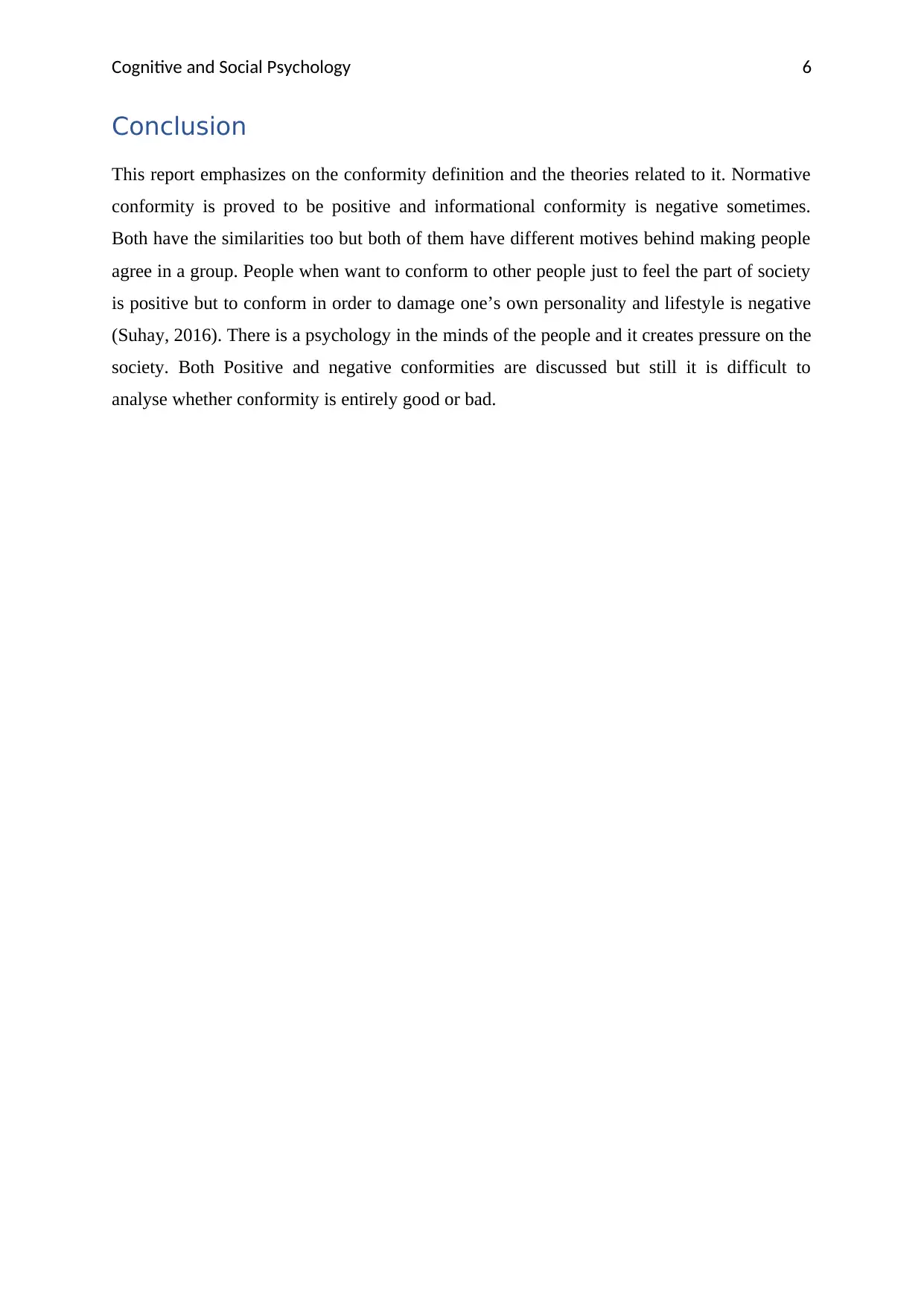
Cognitive and Social Psychology
Conclusion
This report emphasizes on the conformity definition and the theories related to it. Normative
conformity is proved to be positive and informational conformity is negative sometimes.
Both have the similarities too but both of them have different motives behind making people
agree in a group. People when want to conform to other people just to feel the part of society
is positive but to conform in order to damage one’s own personality and lifestyle is negative
(Suhay, 2016). There is a psychology in the minds of the people and it creates pressure on the
society. Both Positive and negative conformities are discussed but still it is difficult to
analyse whether conformity is entirely good or bad.
6
Conclusion
This report emphasizes on the conformity definition and the theories related to it. Normative
conformity is proved to be positive and informational conformity is negative sometimes.
Both have the similarities too but both of them have different motives behind making people
agree in a group. People when want to conform to other people just to feel the part of society
is positive but to conform in order to damage one’s own personality and lifestyle is negative
(Suhay, 2016). There is a psychology in the minds of the people and it creates pressure on the
society. Both Positive and negative conformities are discussed but still it is difficult to
analyse whether conformity is entirely good or bad.
6
Paraphrase This Document
Need a fresh take? Get an instant paraphrase of this document with our AI Paraphraser
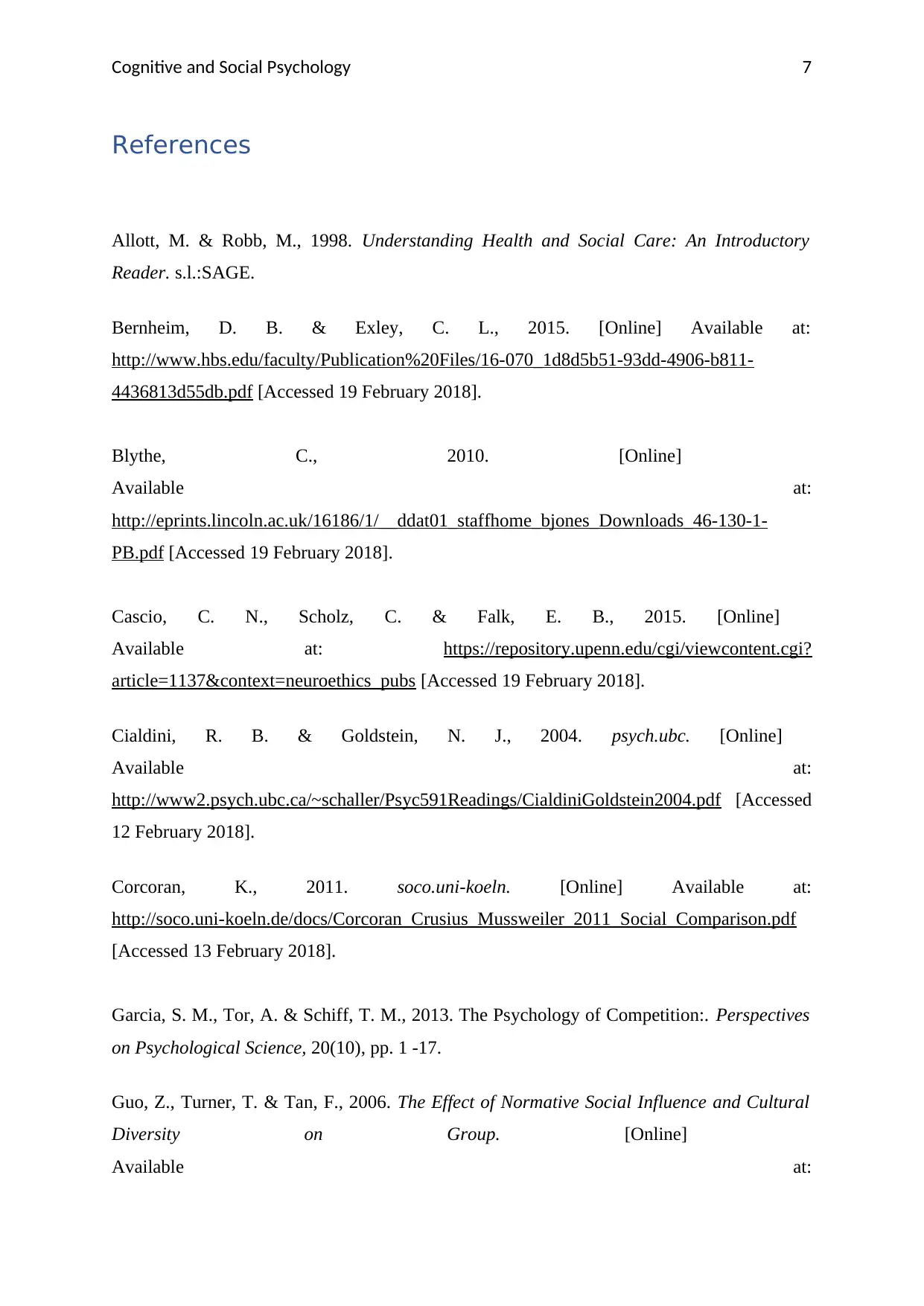
Cognitive and Social Psychology
References
Allott, M. & Robb, M., 1998. Understanding Health and Social Care: An Introductory
Reader. s.l.:SAGE.
Bernheim, D. B. & Exley, C. L., 2015. [Online] Available at:
http://www.hbs.edu/faculty/Publication%20Files/16-070_1d8d5b51-93dd-4906-b811-
4436813d55db.pdf [Accessed 19 February 2018].
Blythe, C., 2010. [Online]
Available at:
http://eprints.lincoln.ac.uk/16186/1/__ddat01_staffhome_bjones_Downloads_46-130-1-
PB.pdf [Accessed 19 February 2018].
Cascio, C. N., Scholz, C. & Falk, E. B., 2015. [Online]
Available at: https://repository.upenn.edu/cgi/viewcontent.cgi?
article=1137&context=neuroethics_pubs [Accessed 19 February 2018].
Cialdini, R. B. & Goldstein, N. J., 2004. psych.ubc. [Online]
Available at:
http://www2.psych.ubc.ca/~schaller/Psyc591Readings/CialdiniGoldstein2004.pdf [Accessed
12 February 2018].
Corcoran, K., 2011. soco.uni-koeln. [Online] Available at:
http://soco.uni-koeln.de/docs/Corcoran_Crusius_Mussweiler_2011_Social_Comparison.pdf
[Accessed 13 February 2018].
Garcia, S. M., Tor, A. & Schiff, T. M., 2013. The Psychology of Competition:. Perspectives
on Psychological Science, 20(10), pp. 1 -17.
Guo, Z., Turner, T. & Tan, F., 2006. The Effect of Normative Social Influence and Cultural
Diversity on Group. [Online]
Available at:
7
References
Allott, M. & Robb, M., 1998. Understanding Health and Social Care: An Introductory
Reader. s.l.:SAGE.
Bernheim, D. B. & Exley, C. L., 2015. [Online] Available at:
http://www.hbs.edu/faculty/Publication%20Files/16-070_1d8d5b51-93dd-4906-b811-
4436813d55db.pdf [Accessed 19 February 2018].
Blythe, C., 2010. [Online]
Available at:
http://eprints.lincoln.ac.uk/16186/1/__ddat01_staffhome_bjones_Downloads_46-130-1-
PB.pdf [Accessed 19 February 2018].
Cascio, C. N., Scholz, C. & Falk, E. B., 2015. [Online]
Available at: https://repository.upenn.edu/cgi/viewcontent.cgi?
article=1137&context=neuroethics_pubs [Accessed 19 February 2018].
Cialdini, R. B. & Goldstein, N. J., 2004. psych.ubc. [Online]
Available at:
http://www2.psych.ubc.ca/~schaller/Psyc591Readings/CialdiniGoldstein2004.pdf [Accessed
12 February 2018].
Corcoran, K., 2011. soco.uni-koeln. [Online] Available at:
http://soco.uni-koeln.de/docs/Corcoran_Crusius_Mussweiler_2011_Social_Comparison.pdf
[Accessed 13 February 2018].
Garcia, S. M., Tor, A. & Schiff, T. M., 2013. The Psychology of Competition:. Perspectives
on Psychological Science, 20(10), pp. 1 -17.
Guo, Z., Turner, T. & Tan, F., 2006. The Effect of Normative Social Influence and Cultural
Diversity on Group. [Online]
Available at:
7
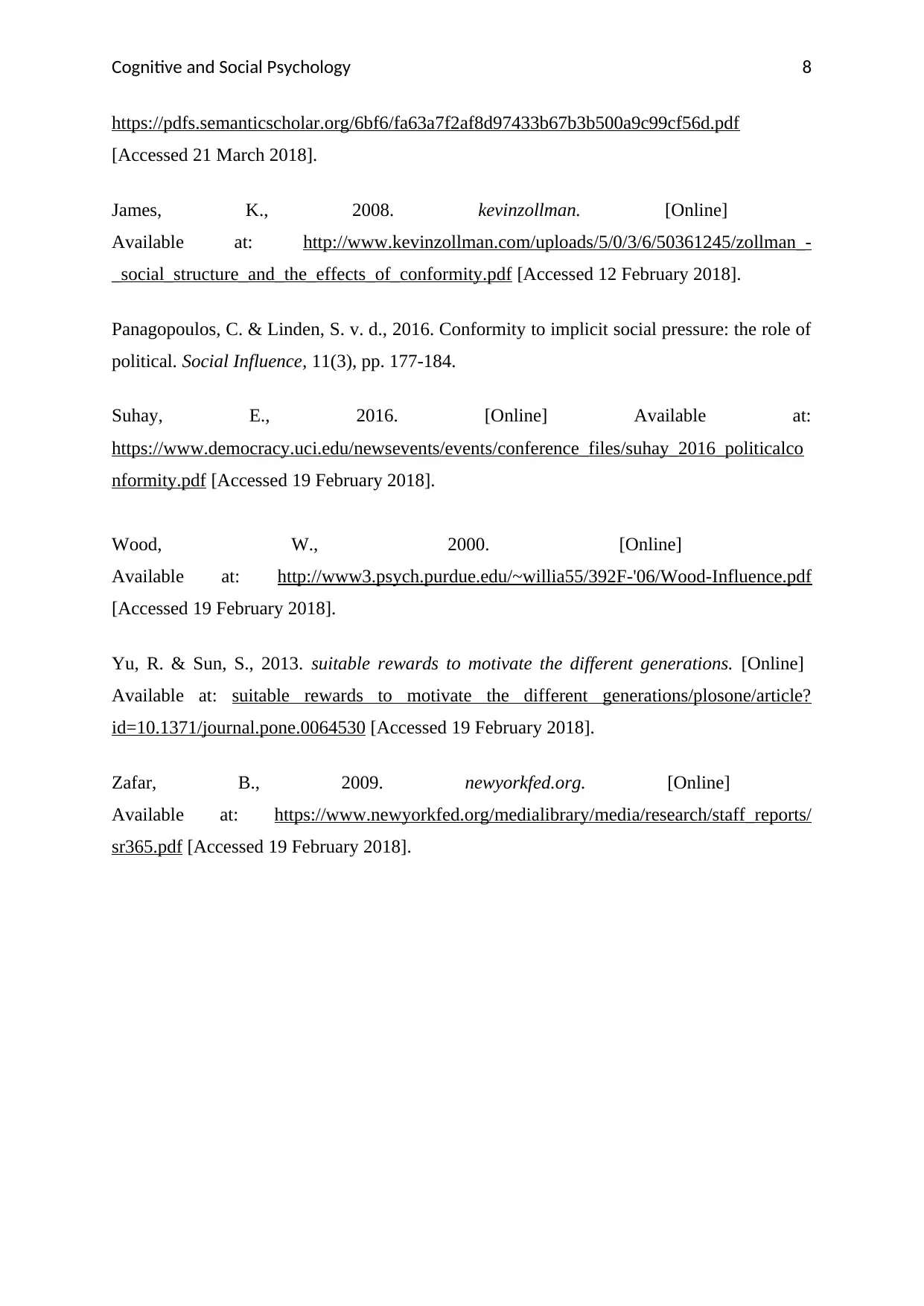
Cognitive and Social Psychology
https://pdfs.semanticscholar.org/6bf6/fa63a7f2af8d97433b67b3b500a9c99cf56d.pdf
[Accessed 21 March 2018].
James, K., 2008. kevinzollman. [Online]
Available at: http://www.kevinzollman.com/uploads/5/0/3/6/50361245/zollman_-
_social_structure_and_the_effects_of_conformity.pdf [Accessed 12 February 2018].
Panagopoulos, C. & Linden, S. v. d., 2016. Conformity to implicit social pressure: the role of
political. Social Influence, 11(3), pp. 177-184.
Suhay, E., 2016. [Online] Available at:
https://www.democracy.uci.edu/newsevents/events/conference_files/suhay_2016_politicalco
nformity.pdf [Accessed 19 February 2018].
Wood, W., 2000. [Online]
Available at: http://www3.psych.purdue.edu/~willia55/392F-'06/Wood-Influence.pdf
[Accessed 19 February 2018].
Yu, R. & Sun, S., 2013. suitable rewards to motivate the different generations. [Online]
Available at: suitable rewards to motivate the different generations/plosone/article?
id=10.1371/journal.pone.0064530 [Accessed 19 February 2018].
Zafar, B., 2009. newyorkfed.org. [Online]
Available at: https://www.newyorkfed.org/medialibrary/media/research/staff_reports/
sr365.pdf [Accessed 19 February 2018].
8
https://pdfs.semanticscholar.org/6bf6/fa63a7f2af8d97433b67b3b500a9c99cf56d.pdf
[Accessed 21 March 2018].
James, K., 2008. kevinzollman. [Online]
Available at: http://www.kevinzollman.com/uploads/5/0/3/6/50361245/zollman_-
_social_structure_and_the_effects_of_conformity.pdf [Accessed 12 February 2018].
Panagopoulos, C. & Linden, S. v. d., 2016. Conformity to implicit social pressure: the role of
political. Social Influence, 11(3), pp. 177-184.
Suhay, E., 2016. [Online] Available at:
https://www.democracy.uci.edu/newsevents/events/conference_files/suhay_2016_politicalco
nformity.pdf [Accessed 19 February 2018].
Wood, W., 2000. [Online]
Available at: http://www3.psych.purdue.edu/~willia55/392F-'06/Wood-Influence.pdf
[Accessed 19 February 2018].
Yu, R. & Sun, S., 2013. suitable rewards to motivate the different generations. [Online]
Available at: suitable rewards to motivate the different generations/plosone/article?
id=10.1371/journal.pone.0064530 [Accessed 19 February 2018].
Zafar, B., 2009. newyorkfed.org. [Online]
Available at: https://www.newyorkfed.org/medialibrary/media/research/staff_reports/
sr365.pdf [Accessed 19 February 2018].
8
⊘ This is a preview!⊘
Do you want full access?
Subscribe today to unlock all pages.

Trusted by 1+ million students worldwide
1 out of 9
Related Documents
Your All-in-One AI-Powered Toolkit for Academic Success.
+13062052269
info@desklib.com
Available 24*7 on WhatsApp / Email
![[object Object]](/_next/static/media/star-bottom.7253800d.svg)
Unlock your academic potential
Copyright © 2020–2025 A2Z Services. All Rights Reserved. Developed and managed by ZUCOL.





